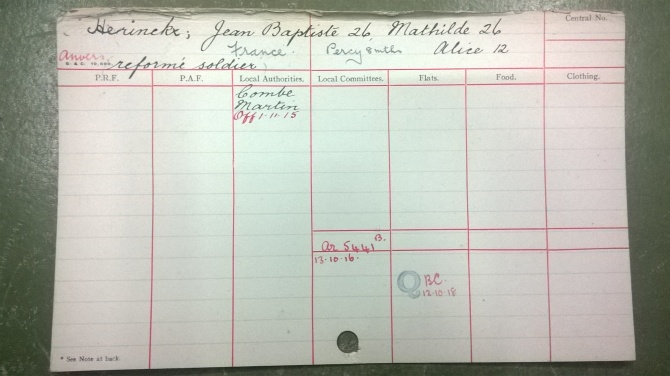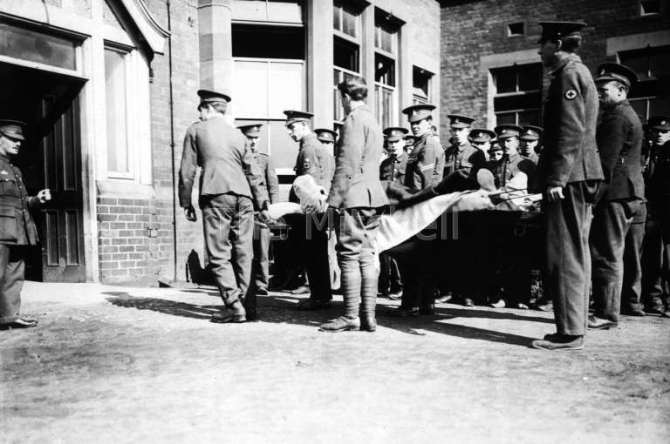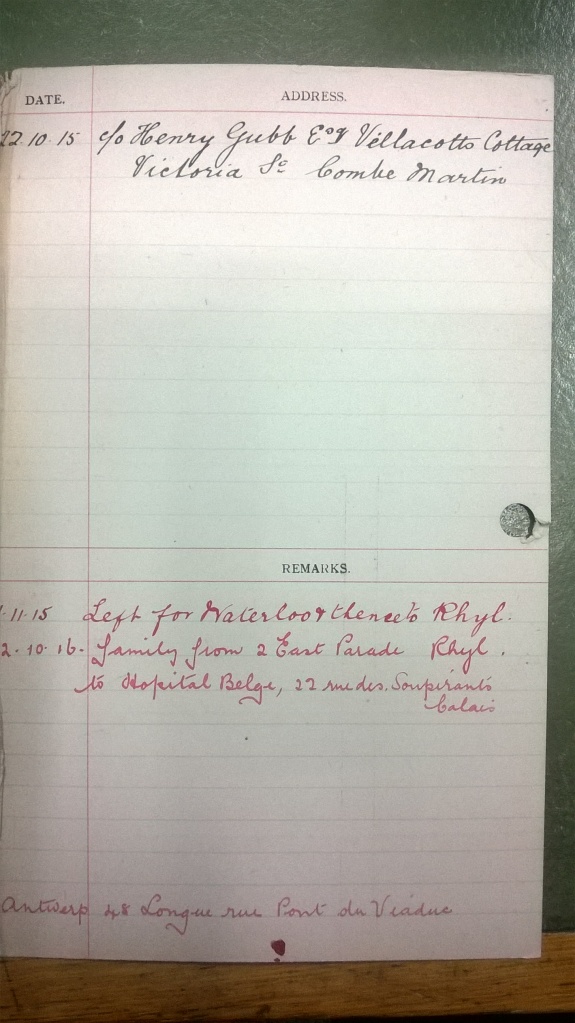Two letters published in the Rhyl Journal during the First World War give a little insight into the lives of some of the Belgian Refugees after they left us. We’ve also managed to find something out about them before they arrived in Rhyl.
Madame Mathilde Herinckx had at some point been the manager of the Belgian Refugee home at 2, East Parade in Rhyl. Madame Herinckx came to the UK as Mathilde Colinet. She married Jean-Baptiste Herinckx in Hendon in March 1915 and, according to the records we found in the National Archives, the family moved to Combe Martin in Devon, to be housed by a Mr. Henry Gubb, Esq.
We set about trying to find some details of the owners of the house in Combe Martin. In response to a request we made to the Combe Martin History Forum facebook page (www.facebook.com/CombeMartinHistoryForum) we were told that that Mr. Thomas Henry Gubb was better known as Harry and that his wife was Gertie. We should thank Mr. Trevor Dunkerley and Mr. Stephen Seldon for the information about the Gubb family and Combe Martin. It was great to connect with them and find all this out.
Harry Gubb was born in 1879 and he died in 1952. In 1916 he was called before the Rural Board for Army service, but was given an exemption. He was employed by Mr. Parsons at the Steam Bakery, Devonia House.
Gertie (Geraldina) nee Collacott died in 1968. They had a son, Willy (William Thomas Henry Gubb).
Gertie and Harry looked after Gertie’s father, and on his death in 1919 she inherited Vellacott Cottage, which was a shop, from him.
*
On October 12th 1915 The Herinckx family arrived at Vellacott Cottage on Victoria Street, Combe Martin.
*
Combe Martin played host to many Belgian Refugees, as can be seen from these newspaper reports at the time. These were very kindly sent to us by Mr. Dunkerley.
The North Devon Journal, December 17th, 1914
It is understood that a suitable house has been taken in Water-terrace, Mill Meadows, Combe Martin, for the reception of eight additional Belgian Refugees. Through the energy of the committee, ably supported by many of the inhabitants, the house has been furnished throughout.
*
The North Devon Journal, December 31st, 1914
Three more families of Belgian Refugees have arrived at Combe Martin, and are living in a furnished cottage at Mill Weter. There are eight women and children, bringing the number of refugees in the township to 13.
*
The North Devon Journal, October 24th, 1918:
COMBE MARTIN
Death of a Belgian Refugee
During the past week there has passed away one of the several Belgian refugees in this parish, In the person Louis Rosier, of Malines, who, with his wife and many other refugees, was sent here about three years ago by the War Refugees Committee, London. Some time ago he had a paralytic stroke, from which he did not recover. On the recommendation of Dr. T. A. Richardson, he was removed on the 11st inst. to the North Devon Infirmary, Barnstaple, where he passed away on Thursday last at the age of 73. Arrangements were made by Mr. C. Willis, the Hon. Secretary of the local Refugees Committee for the Interment of the deceased at the Catholic Burial Ground in the Barnstaple Cemetery. The funeral took place on Saturday afternoon. The widow, with a few Belgian friends from Combe Martin and several Belgians residing at Barnstaple, attended the funeral. Floral tributes were by the Combe Martin refugees, one in the form of a large cross of choice flowers, having the Belgian colours attached thereto. The funeral service was conducted by the Rev. Father Leahy, of Barnstaple. Messrs. Cater and Sons, Victoria-road, Barnstaple, were the undertakers.
It seems the work of the Refugee Committee in Combe Martin did not go unnoticed. Mr. & Mrs. W. C. Willis of the town were recognised in particular:
The North Devon Journal, January 30th 1919
Mr. & Mrs. Willis, of 4, Kingsley-terrace, have been the recipients of a pleasing testimonial from the Belgian Refugees at Combe Martin. The gift consisted of a silver fruit basket and the presentation was made by a deputation of four Belgians, who, with several others, will be leaving the parish very shortly. Mr. W. C. Willis has for four years acted in the capacity of Hon. Secretary of the Belgian Refugees at Combe Martin, under the London Committee (Aldwych). A number of Refugees have already left the parish to proceed to their native country.
*
…but the recognition of Mrs. Willis went even further than that:
The North Devon Journal, February 5th, 1920
During the past week, Mrs. Willis of “Kingsley”, has been the recipient of the Queen Elizabeth medal from the Belgian Ambassador in London, accompanied by the Royal Warrant and the following letter:- “Madam, I have the honour to forward you herewith the insignia of the Medaille de la Reine Elizabeth, which his Majesty the King of the Belgians has been graciously pleased to confer upon you in recognition of the kind and valuable assistance you have personally given to the Belgian Refugees and the Belgian Soldiers during the war.”*
*
The Herinckx Family
Our family – Jean-Baptise and Mathilde Herinckx – both aged 26 – and a 12 year old girl named Alice were sent to live in the house owned by the Gubb family.
This is the front of the record card held as part of MH8 in the National Archives:
They didn’t stay too long though, as we found from the record card in the National Archives that in November 1915 – only a month after they arrived in Combe Martin – they “left for Waterloo and thence to Rhyl.”
Whilst Jean and Mathilde were in Rhyl their baby Percy JB Herinckx was born.
*
It seems that Jean-Baptiste Herinckx was wounded. On his record card in the National Archives he is listed as a “reformé soldier” – that is a soldier who has been discharged because of wounds or illness. In the Rhyl Journal dated February 5th 1916 there is mention of a wounded male refugee: “only one is of military age and he has been certified medically unfit for service”. Indeed, Mathilde makes reference to his “wounds” in one of her letters to the Rhyl Journal.
We searched for records which may give us a little more information about Jean, and could only find one reference to a Jean Herinckx as far as wounded soldiers go. It appeared in the Daily Record and Mail of Wednesday, October 21st 1914, where listed among 270 other wounded Belgian Servicemen is Jean Herinckx. The article discusses the wounded being taken by train the Stobhill Hospital in Glasgow which had been requisitioned by Royal Army Medical Corps staff of the Territorial Force. The complex was split and re-designated as the 3rd and 4th Scottish General Hospitals. Wounded servicemen arrived by specially converted hospital trains terminating at a temporary railway platform built within the hospital grounds. A staff of 240 nurses as well as volunteers from the St. Andrew’s Ambulance Association cared for over 1,000 patients at a time until the return of the hospital to civilian use in the spring of 1920.
This photograph shows the first arrivals at Stobhill:
This is the reverse of the Herinckx family record card, which shows all listed movements for the family:
In October 1916 the family moved to France. The record card states “Family from 2 East Parade, Rhyl, to Hospital Belge, 22 Rue des Soupirants, Calais.
It seems that many buildings were commandeered to be hospitals on this street in Calais. Indeed, the website www.14-18.be/service_sante_etablissements.php lists numbers 6, 22, 27, 51 and 55 Rue des Soupirants as hospitals. Today, this looks like a quiet residential area and number 22, which operated as a hospital from October 1914 to January 1919, is a moderately-sized three storey apartment house.
*
These two letters, found in the Rhyl Journal, were kindly emailed to us by Mr. Derek Bond. One makes reference to a previous letter, but we have been unable to find that.
*
Rhyl Journal, November 11th, 1916
“Grateful Belgians”
To the editor of the Rhyl Journal,
8, Allee de la Convention, Pavillons Bois, Seine, France.
Dear Sir:-
I hope you will be so kind as to put another little note in your paper to tell all our friends that I arrived in France safely. I am at the above address, probably for another month or two. I hope to be back in Rhyl very soon. I won’t forget you. I have not met such nice people as the Rhyl people. I hope you will send me the “Rhyl Journal” every week, to the above address, and put this in your paper.
I still remember every friend, but it is difficult to write to everyone; that is why I ask you to remember me, also the little boy Percy, Alice and my husband to all of you. My husband is getting a little better of his wounds and he is also very anxious to be back in Rhyl, – I am, &c.,
M. Herinckx.
*
*
Rhyl Journal, September 15th, 1917
“Grateful Belgians”
Madame Herinckx writes to us as follows from France:-
“Mrs. Herinckx, manager of the Belgian home, and dressmaker after the Belgians left, is so glad to inform her old friends and benefactors of the birth of a little girl, Mathilde Marie Therese. She is glad to say the mother and baby are alright. Baby Percy, who is now 19 months old, remembers his birthplace, and is beginning to talk English, and as soon as we are able to cross again baby Percy will be able to talk to his old benefactors. Alice is growing fast, and remembers all her friends. Mr. Herinckx wishes to thank the people of Rhyl.”
*
*
*The Médaille de la Reine Elisabeth was a Belgian decoration created by Royal Decree on September 15th 1915 to recognise exceptional services to Belgium in the relief of the suffering of its citizens during the First World War.




